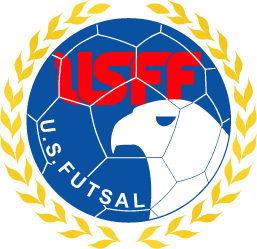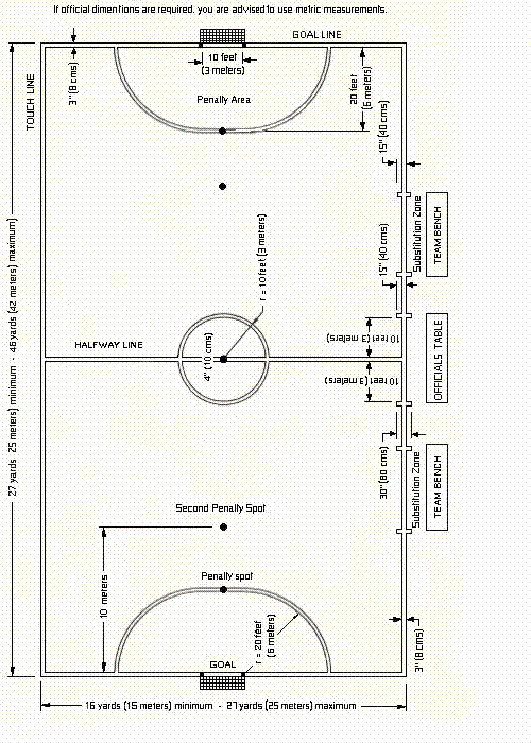 |
 | |
|
LAW I
LAW II - The Ball
LAW III -
Number of Players
LAW IV - Players' Equipment Usual Equipment:
Numbered shirts, shorts, socks, protective shin-guards and footwear with
rubber soles
LAW V - Main Referee
· Duties:
Enforce the laws, apply the advantage rule, keep a record of all incidents
before, during and after game, stop game when deemed necessary, caution or
expel players guilty of misconduct, violent conduct or other ungentlemanly
behavior, allow no others to enter the pitch, stop game to have injured
players removed, signal for game to be restarted after every stoppage, decide
that the ball meets with the stipulated requirements.
· Position:
The side opposite to the player benches
· Power
Unique to Main Referee: Can overrule Assistant Referee's calls.
LAW
VI: Second Referee
·
Duties: Same as Main Referee, with the addition of keeping a check on
the
· Position:
The same side as the player benches
LAW VII - Timekeeper · Duties: Start game clock after kick-off, stop it when the ball is out of play, and restart it after all restarts; keep a check on 2-minute punishment for sending off; indicate end of first half and match with some sort of sound; record time-outs and fouls (and indicate when a team has exceeded the 5-foul limit); record game stoppages, scorers, players cautioned and sent off, and other information relevant to the game.
·
Position:
Outside halfway line on the same side as the substitution zone (i.e., the
players' bench side)
LAW VIII - Duration of the Game
·
Duration:
Two equal periods of 20 minutes; clock stopped whenever ball is out of play.
Time can be prolonged only to take a penalty kick.
· Time-outs:
1 per team per half; none in extra time
· Half-time:
Maximum of 15 minutes
LAW
IX - The Start of Play
Procedure: Coin toss
followed by kickoff; opposing team waits outside center circle; ball deemed in
play once it has been touched; the kicker shall not touch ball before someone
else touches it; ensuing kick-offs taken after goals scored and at start of
second half.
·
Ball out
of play: When it has wholly crossed the goal line or touchline; when the game
has been stopped by a referee; when the ball hits the ceiling (restart:
dropped ball beneath that point).
· Lines:
Touchlines and goal lines are considered inside the playing area.
LAW XI - Method of Scoring
When the whole of the ball has passed over the
goal line, between the goal posts and under the crossbar (except by illegal
means). LAW XII - Fouls
and Misconduct Direct free kick awarded when a player intentionally commits any of the following 11 offenses (penalty kick awarded when infringement takes place in penalty area)
· kicking or
attempting to kick an opponent
· tripping an
opponent
· jumping at an
opponent
· charging an
opponent in a violent or dangerous manner
· charging an
opponent from behind
·
striking,
attempting to strike, or spitting at an opponent
· holding an
opponent
· pushing an
opponent
· charging an
opponent with shoulder (i.e., shoulder charge)
· sliding at an
opponent (i.e., sliding tackle)
· handling the
ball (except goalkeeper)
Indirect free kick awarded when any of the following 8 offenses is committed (kick taken
from the 6-meter line when infringement takes place in penalty area):
· dangerous play
(e.g. attempting to kick ball held by goalkeeper)
·
obstruction
· charging the
goalkeeper in the penalty area (i.e., goalkeeper charge)
· goalkeeper throws
ball directly over the halfway-line (without it first touching his own side of
the pitch or any player)
· goalkeeper picks
up or touches with his hands a back pass
· goalkeeper picks
up or touches with his hands a kick-in from a teammate
· goalkeeper
controls the ball with any part of his body for more than 4 seconds
· goalkeeper
touches with any part of his body a back pass that has been played back to him
before the ball has (1) crossed the halfway-line or (2) been touched by an
opponent
Players shall be
cautioned
(i.e., shown yellow card) when:
· a substituting
player enters the pitch from an incorrect position or before the player he is
substituting has entirely left the pitch
· he persistently
infringes the Laws of the Game
· he shows dissent
with any decision of the referee
· he is guilty of
ungentlemanly conduct
These 4 yellow-card offenses
are punishable by an indirect free kick taken from the point of
infringement (or from the 6-meter line when the infringement takes place in
penalty area). Players shall be
sent off
(i.e., shown the red card) for:
·
(a) serious foul
play
·
(b) violent
conduct
·
(c) foul or
abusive language
·
(d) second
instance of
cautionable offense (i.e., second yellow card)
·
(e) intentionally
impeding a clear goal opportunity (e.g. through a "professional foul")
·
(f) intentionally
impeding a clear goal opportunity in the penalty area by handling the ball
Direct
free kicks (or penalty kicks) accompany the expulsion for (a), (b), (e) and (f);
indirect free kicks, for (c) and (d) (from the 6-meter line when the
infringement takes place in the penalty area).
Rules of Expulsion:
·
The player sent
off (shown a red card) is out for the rest of the game and is not even permitted to sit on the
reserves' bench.
·
The team of the player sent off
can substitute for that player after 2 minutes of playing time or after the
opposing team scores -- which ever comes first.
·
The 2-minute
punishment shall be checked by the timekeeper (or by the assistant referee, if there is no timekeeper).
· The substitute
cannot come on until the ball is out of play and he has a referee's consent.
LAW XIII - Free Kick
·
Types: Direct
free kicks and indirect free kicks
·
Wall: At least 5 meters away until
the ball is in play
·
Ball
in Play: After it has traveled the distance of its own circumference
·
Time Limit: Kick must be taken within 4
seconds
·
Restriction: Kicker cannot touch the ball
again until it has been touched by another player
LAW XIV - Accumulated Fouls Accumulated fouls refer only
to all the fouls mentioned in Law XII (a through k(1 to 11). Once a team has accumulated
5 fouls during a half (those accumulated in the second half continue to
accumulate into extra time), from the 6th foul:
·
that team shall not be
allowed a defensive wall
·
all free kicks shall be
direct (no indirect free kicks)
·
infringements
committed within 12 meters of the goal line shall be punished with a direct free
kick from the point of infringement; infringements committed from 12 meters or
further from the goal line shall be punished with a direct free kick from the
Second Penalty Spot
Procedure:
·
Until the ball is
kicked into play, all players other than the goalkeeper and kicker shall remain
behind an imaginary line that is in line with the ball and parallel to the goal
line.
·
The goalkeeper
shall remain in his penalty area at least 5 m away from the ball.
·
The kicker must
aim at the goal, with the intention of scoring.
·
No other player
may touch the ball until it has been touched by the pitch, rebounded from the
goal post or crossbar, or has left the pitch.
·
If the
infringement took place in penalty area (and does not merit a penalty kick), the
free kick is to be taken from the 6-m-line on the spot nearest to where the
infringement occurred.
LAW XV - Penalty Kick
·
To be taken from
the penalty mark on the mid-point of the 6-m-line.
·
The kicker is to
aim at goal, with the intention of scoring.
·
All players must
be out of the penalty area, and the players of the opposing team must also be at
least 5 m from the penalty spot.
· The kicker shall
not play the ball a second time until it has been touched by another player.
LAW XVI - Kick-in
· To be taken in
place of the throw-in.
· The
ball is placed on the touch line before kicking.
·
The kicker's foot
not kicking the ball must be outside or at least on the touchline; if it crosses
the touchline all of the way, into the pitch, the kick-in is given to the
opposing team.
·
The kick-in must
be taken within 4 seconds; if it is not, the kick-in is given to the opposing
team.
·
The kicker cannot
play the ball a second time until it has been played by another player;
infringement of this rule entail an indirect free kick to the opposing from the
point of infringement.
· Players on
opposing team must be at least 5 m away from point of kick-in.
· Cannot score
directly from a kick-in.
LAW XVII - Goal Clearance
·
To be taken in
place of goal kick.
·
From inside the
penalty area, the goalkeeper throws the ball into play.
·
The ball is not
in play until it has passed outside of the penalty area. If the goal clearance
is received inside of the penalty area, the goal clearance shall be taken over.
LAW XVIII - Corner Kick
·
Ball placed on
the corner (no corner-kick arc). If ball is misplaced, the corner kick is taken
over.
·
Must be taken within 4 seconds;
failure to do so entails indirect free kick to the opposing team from the corner
mark.
·
The kicker cannot
play the ball a second time until it has been played by another player;
infringement of this rule entail an indirect free kick to the opposing from the
point of infringement.
· Players on
opposing team must be at least 5 m away from point of the corner kick.
· Can score goal
directly from a corner kick.
Annex 1 - Penalty Kick Shoot-out
· Main referee
decides goal to be used.
· Coin tossed to
decide order.
· Five kicks to be
taken by 5 different players selected from the 12 suited players. Captain of
each team announces these 5 to the main referee before the kicks are taken.
· If two teams are
still tied after 5 kicks, the additional kicks will be taken on a sudden-death
basis by the rest of the players who have not kicked yet.
· Players sent off
during the match are not eligible to take these kicks.
· Any eligible
player may change places with his goalkeeper.
·
While the penalty
shoot-out is in progress, players will remain on the opposite half of the pitch.
The assistant referee shall control this area.
|
||
